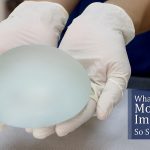High-Intensity Focused Ultrasound (HIFU) is a non-invasive medical procedure gaining attention in the realm of cosmetic dermatology. This treatment uses focused ultrasound waves to specifically target tissues beneath the skin’s surface without affecting adjacent areas. This article aims to provide insights into HIFU’s benefits, focusing on its role in skin rejuvenation.
Understanding HIFU
High-Intensity Focused Ultrasound (HIFU) is a non-invasive medical procedure that utilizes the potency of focused ultrasound waves to tighten and rejuvenate the skin. HIFU operates on the principle of precise energy delivery to targeted areas beneath the skin’s surface without affecting the surrounding tissues. HIFU is designed to deliver ultrasound energy with a high level of precision to specific layers beneath the skin, typically focusing on the dermis and the superficial musculoaponeurotic system (SMAS), which is deeper than the dermis.
Here’s how HIFU spares the surrounding tissues:
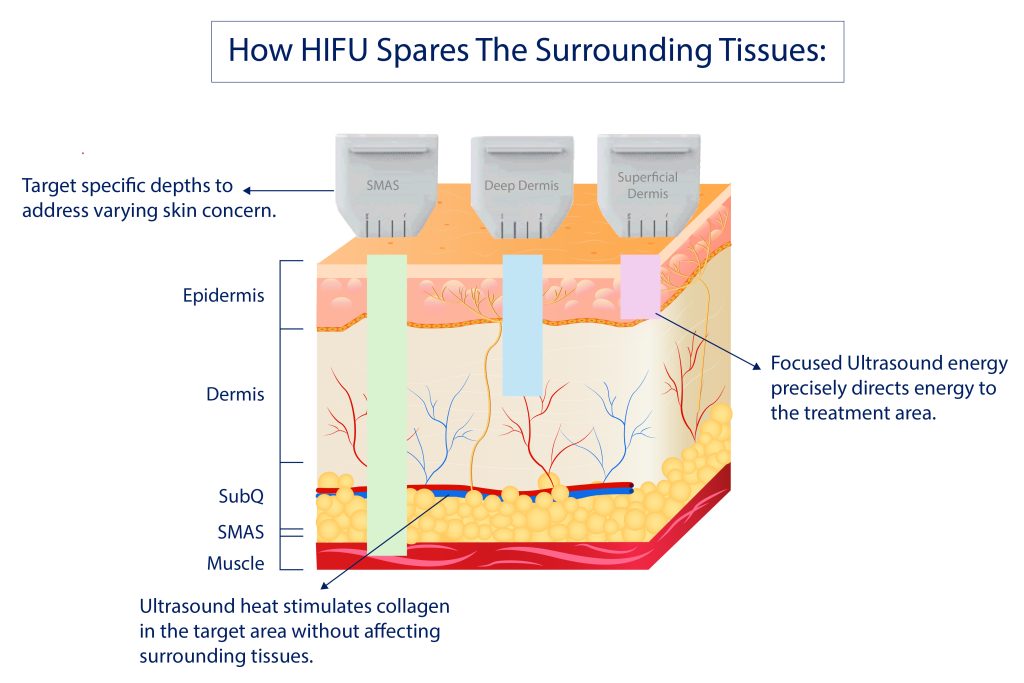
- Focused Ultrasound Energy: HIFU uses ultrasound waves that are concentrated at a specific point deep within the skin. This focus point is where the energy is the highest, and it’s precisely controlled. Above and below this focal point, the energy levels are significantly lower. As a result, the layers of skin and tissues outside the target area remain unaffected.
- Selective Heating: At the focal point, the ultrasound energy creates heat. This heat is responsible for initiating therapeutic effects, like stimulating collagen production. However, this heating is localized and does not extend to the adjacent areas. Thus, while the targeted area undergoes changes due to the heat, the surrounding tissues do not experience this heating and remain unaltered.
- Depth Precision: HIFU devices are equipped to target specific depths. This means that the doctor can adjust the device to focus the ultrasound energy at the precise depth required for the desired effect, whether it’s closer to the surface for superficial treatments or deeper for more profound skin tightening. This control ensures that only the intended depth of tissue is affected.
The mechanism of HIFU treatment revolves around the selective thermal coagulative process initiated by the focused ultrasound waves. During the procedure, the HIFU device delivers energy to the targeted tissue, causing a rapid increase in temperature within the focal point. This localized rise in temperature leads to the coagulation of targeted collagen fibers, thereby initiating the body’s natural healing response. As a result, the treated area undergoes a process of collagen remodeling and regeneration, leading to enhanced skin elasticity and firmness over time.
HIFU treatment should be performed by certified doctors who utilize specialized HIFU equipment to administer precise and controlled ultrasound energy to the designated treatment areas. The procedure begins with the application of a conductive gel to the targeted skin area, ensuring optimal transmission of ultrasound waves. The doctor then maneuvers the handpiece of the HIFU device over the designated regions, delivering focused energy pulses to the predetermined depths within the skin. The doctor calibrates the settings after examination, which enables the treatment to bypass the surface layers of the skin, ensuring minimal discomfort and no damage to the surrounding tissues.
Non-Invasive Approach of HIFU Treatment
The non-invasive approach of High-Intensity Focused Ultrasound (HIFU) is an option for people who are not keen to go under surgical treatments or early preventive method for individuals with early signs of skin sagging. This attribute is particularly of value for patients who are apprehensive about surgical procedures or those who are not suitable candidates for surgery due to various health concerns.
In traditional surgical procedures, incisions are made to access and modify the targeted area, which can increase the risk of complications such as infection, scarring, and extended recovery periods. In contrast, HIFU utilizes ultrasound energy, which is directed precisely at specific depths beneath the skin’s surface. This technique allows for the treatment of the targeted tissue without any disruptions to the skin’s outer layer.
The procedure is typically performed in a clinical setting and does not require general anesthesia, which is often a necessity in surgical interventions. The absence of general anesthesia not only reduces risks associated with anesthesia but also eliminates the need for pre-operative fasting and post-operative recovery time. Patients can usually undergo the HIFU treatment and return to their daily activities almost immediately, which is also highly preferred for those who cannot afford extended downtime.
Furthermore, the non-invasive nature of HIFU minimizes discomfort during the procedure. Patients may experience sensations of heat or tingling as the ultrasound energy is delivered, but these are generally well-tolerated. The procedure’s duration varies depending on the treatment area but typically lasts between 30 to 90 minutes.
Stimulating Collagen Production
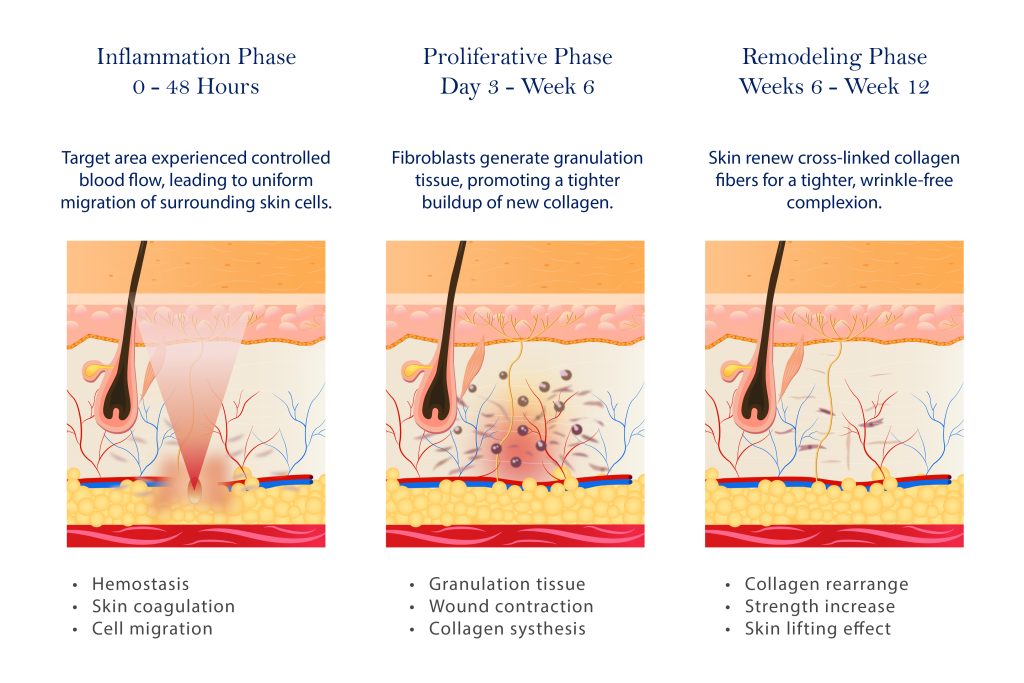
In the context of HIFU treatment, the stimulation of collagen production is a central component. Collagen, a naturally occurring protein, is fundamental to maintaining skin structure and elasticity. Over time, our bodies produce less collagen, leading to common signs of aging like wrinkles and skin laxity.
HIFU leverages ultrasound energy to target specific depths under the skin, typically ranging from 1.5 to 4.5 millimeters. This energy heats small targeted tissue areas, initiating a process known as neocollagenesis. Neocollagenesis is the body’s response to this targeted thermal injury. It starts a healing process where fibroblasts, cells crucial for tissue repair, are activated. These fibroblasts then produce new collagen fibers.
By stimulating the body’s own collagen-producing mechanisms, HIFU promotes a type of skin rejuvenation that doesn’t rely on artificial fillers or external substances. The new collagen that forms as a result of the treatment helps to gradually improve the skin’s texture and elasticity.
This collagen production is not instantaneous. It improves over several months, meaning that the skin’s appearance continues to improve post-treatment. Patients typically observe initial improvements within a few weeks, with the most significant changes visible after two to three months as the collagen regeneration process reaches its peak.
Enhanced Skin Firmness with HIFU Treatment
The HIFU treatment’s ability to enhance skin firmness is grounded in its targeted approach to stimulating deeper skin layers. It’s important to understand how the underlying structure of our skin contributes to its firmness and how HIFU interacts with these structures.
Targeting Deeper Skin Layers
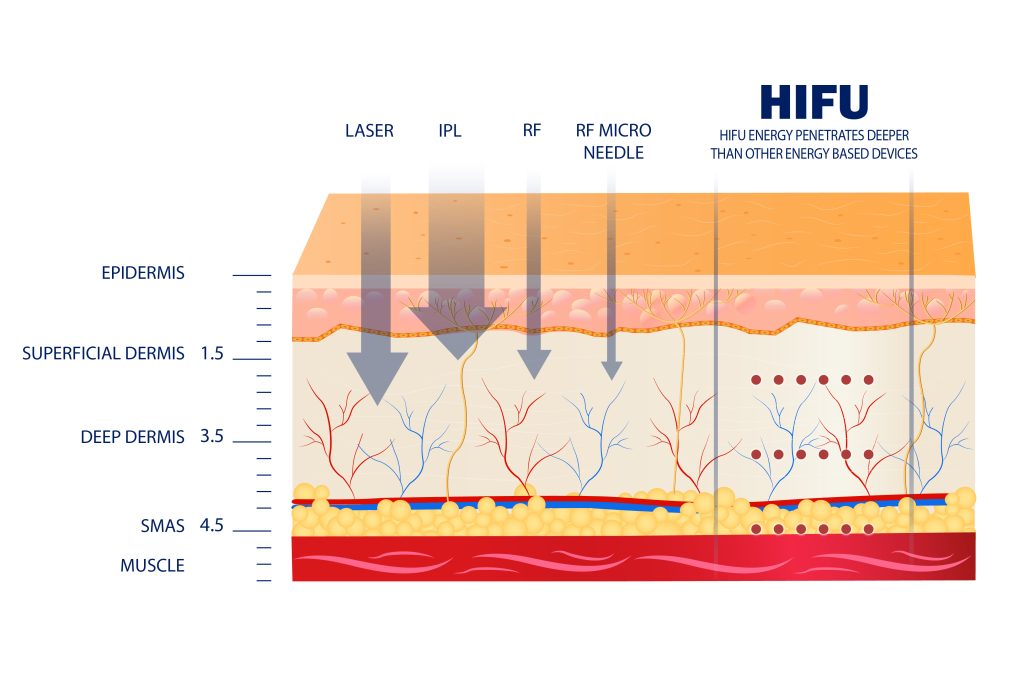
Our skin comprises several layers, each playing a distinct role in its appearance and health. The SMAS (Superficial Muscular Aponeurotic System) layer, lying deep beneath the skin’s surface, is particularly crucial. It’s this layer that is often targeted in traditional facelift surgeries for its role in facial structure and firmness. HIFU’s ultrasound waves reach this deep layer, causing a tightening and lifting effect. This process is akin to ‘toning’ the skin from the inside out, leading to a more defined and firmer appearance.
The Role of Collagen and Elastin
Collagen and elastin are proteins vital for maintaining the skin’s structural integrity and elasticity. While collagen provides rigidity and strength, elastin allows the skin to return to its shape after stretching or contracting. With age, the production of these proteins diminishes, leading to sagging and wrinkles. HIFU stimulates the natural production of collagen and, to a lesser extent, elastin, by creating focused thermal injury zones in the skin’s deeper layers. This ‘injury’ triggers the body’s natural healing response, leading to increased collagen and elastin production.
Gradual Tightening and Lifting
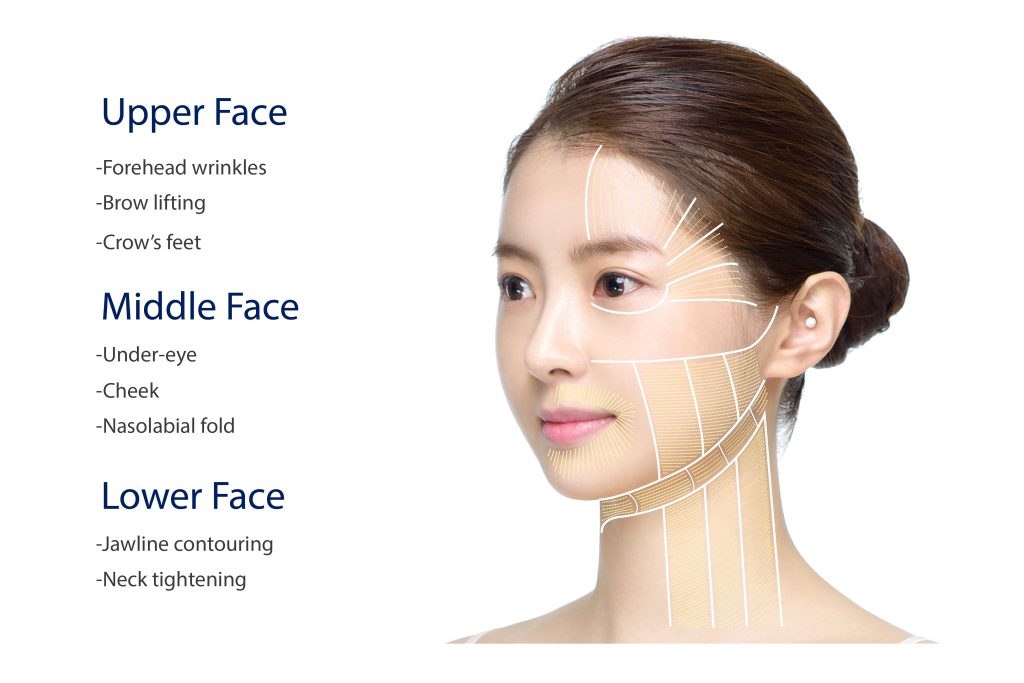
The tightening effect from HIFU doesn’t occur instantly but unfolds over time. Post-treatment, as the body ramps up its collagen production, patients gradually notice their skin becoming firmer and more lifted. This process can take several weeks to months, with improvements typically noticeable within 2 to 3 months post-treatment.
Safety and Suitability
Safety is a key consideration in HIFU treatments. While HIFU is generally safe for all skin types, it’s essential to have a thorough consultation with a healthcare provider to assess suitability, especially for individuals with certain skin conditions or underlying health issues.
Comprehensive Approach
For optimal results, HIFU may be part of a comprehensive skincare regimen. While it significantly contributes to skin firmness, combining it with other treatments and good skincare practices can enhance overall skin health and appearance.
Results Expectation from HIFU treatment
Typically, the effects of HIFU can last up to 6 months, but this can vary depending on individual factors such as age, skin condition, and lifestyle. This duration of effectiveness is noteworthy when compared to many non-invasive skin treatments.
Post-Hifu treatment continues to stimulate new collagen in the skin. Factors like sun exposure, diet, and general health can influence the rate at which skin ages. Therefore, maintaining the results of HIFU can be supported by a healthy lifestyle, including sun protection, a balanced diet, and proper skin care.
Some patients may see initial improvements shortly after treatment, but the full results are typically observed several months later, as collagen production continues. The gradual nature of these improvements contributes to the perception of enduring results.
Moreover, the durability of HIFU results also depends on the skill of the doctor and the type of equipment used. A thorough consultation and treatment by an experienced and certified doctor may maximize the effectiveness and longevity of the results.
Progressive Improvement with HIFU
The progressive improvement observed in HIFU treatments is a key aspect that sets it apart from many other cosmetic interventions. This gradual process is not just a matter of appearance but also a reflection of the underlying biological changes happening within the skin.
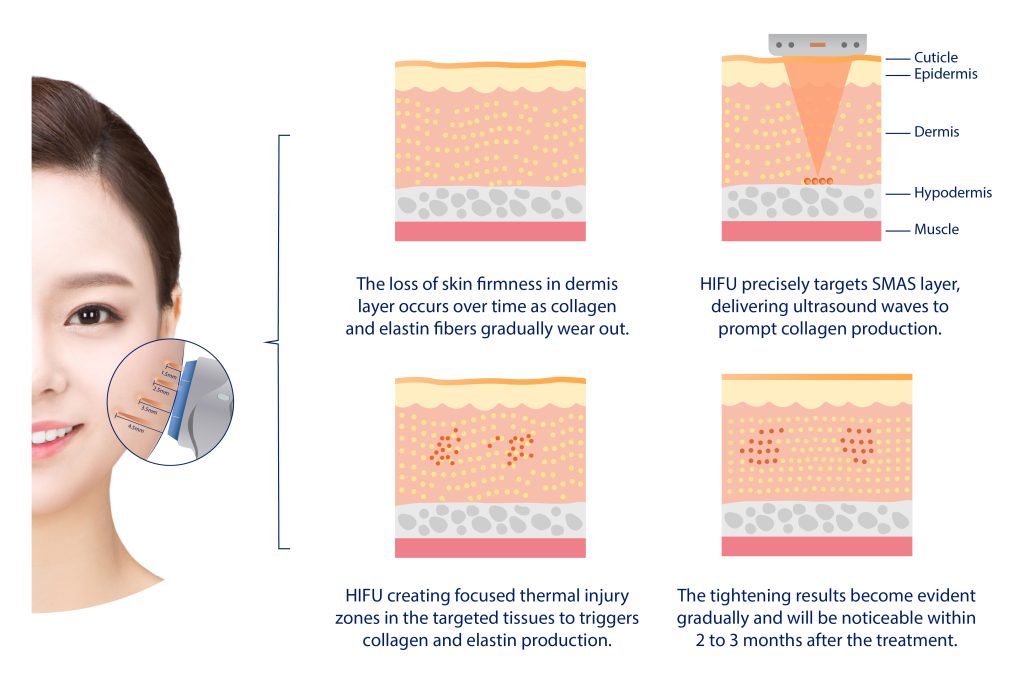
When HIFU is used, the ultrasound waves create controlled thermal injury at specific depths under the skin. This process, while not causing damage to the surface skin or surrounding tissues, initiates the body’s natural healing response. One of the primary responses is the stimulation of collagen synthesis.
Collagen is a protein that provides structure and elasticity to the skin. As we age, natural collagen production declines, leading to signs of aging such as wrinkles and sagging. The thermal effect of HIFU kick-starts the body’s collagen-building process. However, this is not an instant process. The full benefits of increased collagen production are realized over time, as the body gradually repairs and strengthens the skin’s support structure.
Patients typically start to see some initial effects immediately after the treatment, but the most noticeable improvements develop over the following three to six months. This time frame allows for the natural cycle of collagen regeneration, ensuring that the skin’s rejuvenation process aligns with the body’s own physiological rhythms.
Moreover, this progressive improvement means that changes to the skin’s appearance are more subtle and natural-looking. It also allows for a more controlled and predictable outcome, with the ability to monitor and evaluate the skin’s response over time.
Assessing Suitability for HIFU Treatment: Who May Not Benefit
While HIFU has shown results in skin tightening for many, it’s important to recognize that not everyone is an ideal candidate for this treatment. Understanding who may not benefit from HIFU is crucial, and underscores the importance of a thorough assessment by a healthcare professional.
Individuals Less Likely to benefit from HIFU
1. Severe Skin Laxity: Those with significantly loose or excessively sagging skin might not see optimal results from HIFU. In such cases, the level of skin laxity may be beyond the correcting capacity of non-surgical methods like HIFU, and surgical interventions might be more appropriate.
2. Very Thin Skin: Individuals with extremely thin skin might not respond well to HIFU. The effectiveness of HIFU partly relies on the ability of the skin to respond to the thermal injury induced by ultrasound waves and stimulate collagen production. Thinner skin may not have sufficient collagen-rich layers to achieve the desired results.
3. Certain Skin Conditions: People with certain skin conditions that affect skin healing might not be suitable candidates for HIFU. This includes conditions like severe acne, eczema, or psoriasis in the treatment area.
4. Younger Individuals: While not necessarily a contraindication, younger individuals (typically in their 20s or early 30s) with minimal signs of aging may not see significant benefits, as the treatment is more effective in addressing moderate signs of aging.
Importance of Professional Assessment
A detailed assessment by a certified doctor is paramount before undergoing HIFU. This assessment should include:
1. Evaluation of Skin Condition: The doctor will examine the skin’s elasticity, thickness, and overall condition to determine if HIFU is suitable.
2. Medical History Review: A thorough review of medical history, including any medications, past treatments, and underlying health conditions, is crucial to assess suitability and minimize risks.
3. Setting Realistic Expectations: It’s important for the healthcare provider to discuss what HIFU can and cannot achieve. This conversation helps set realistic expectations regarding the results.
4. Discussing Alternatives: If HIFU is not suitable, the doctor may recommend alternative treatments better suited to the individual’s skin condition and aesthetic goals.
Bottomline
The progressive improvement with HIFU is a testament to its alignment with the body’s natural healing and regeneration processes. This characteristic makes it a much-preferred choice for those seeking a more natural approach to skin rejuvenation, allowing for a gradual, yet noticeable, enhancement in skin texture and firmness. As always, it’s important for individuals to consult with a certified Aesthetic Doctor Singapore to understand the full scope of the treatment and its suitability for their specific skin concerns.
For more comprehensive advice, individuals may also consider consulting a plastic surgeon Singapore or a cosmetic surgeon Singapore to explore all available options for skin rejuvenation.







